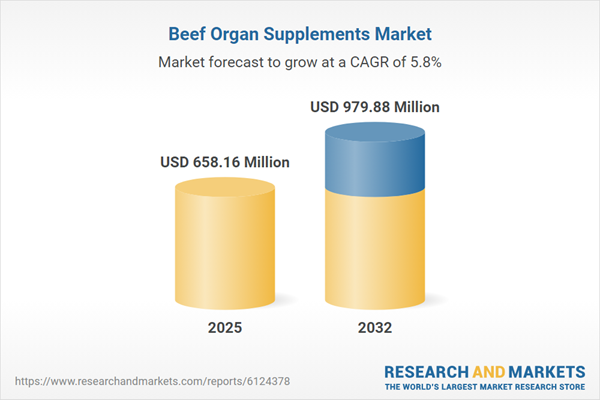Speak directly to the analyst to clarify any post sales queries you may have.
The beef organ supplements market is experiencing accelerated growth as health-conscious consumers, regulatory reforms, and technological innovation converge, setting new standards for quality, transparency, and efficacy. Senior decision-makers must track evolving demand preferences and disruption within the dietary supplement sector to remain competitive.
Market Snapshot: Beef Organ Supplements Market Size and Growth
According to the latest research, the Beef Organ Supplements Market grew from USD 623.85 million in 2024 to USD 658.16 million in 2025 and is projected to expand at a CAGR of 5.80% to reach USD 979.88 million by 2032.
Scope & Segmentation
- Form Types: Includes capsules, gummies, powder, softgels, liquid formats, and tablets, serving varied administration needs.
- Organ Composition: Categories range from multi-organ blends to single-organ products such as adrenal, bone marrow, brain, heart, kidney, liver, pancreas, spleen, thymus, and thyroid.
- Processing Method: Utilizes freeze drying and heat drying, each impacting nutrient retention and product shelf-life.
- Application: Supports energy boost, general wellness, immune support, joint and bone health, metabolic and endocrine balance (including blood sugar, hormone, and thyroid regulation), prenatal nutrition, and sports nutrition with focus areas like endurance, muscle repair, and recovery.
- End User: Targets adults, athletes, children, elderly, and pregnant women, reflecting a diverse and expanding user base.
- Distribution Channel: Encompasses offline outlets (pharmacies, drugstores, supermarkets, hypermarkets) and online platforms (brand websites, e-commerce sites).
- Regional Coverage: Includes Americas (North America, Latin America), Europe, Middle East & Africa (with specific breakout of United Kingdom, Germany, France, Russia, Italy, Spain, Netherlands, Sweden, Poland, Switzerland, United Arab Emirates, Saudi Arabia, Qatar, Turkey, Israel, South Africa, Nigeria, Egypt, Kenya), and Asia-Pacific (China, India, Japan, Australia, South Korea, Indonesia, Thailand, Malaysia, Singapore, Taiwan).
- Key Industry Players: Market landscape features Ancestral Supplements, LLC, Perfect Supplements, LLC, Heart & Soil, LLC, Amazing Nutrition, LLC, Antler Farms NZ Ltd., Carnos, LLC, Codeage LLC, Enviromedica, Jarrow Formulas, Inc., Life Extension, Thorne Research, Inc., Nordic Kings Supplements AB, Organika Health Products Inc., Swanson Health Products, Inc., and others.
Key Takeaways for Senior Decision-Makers
- The drive toward ingredient transparency and traceability is redefining quality benchmarks; blockchain and third-party certifications now play critical roles in sourcing authenticity.
- Technological progress, including cold-processing and solvent-free extraction, strengthens claims regarding bioavailability and nutritional integrity, positioning products as evidence-based supplements.
- Consumer demand has diversified, with omnichannel retail and digital engagement expanding trial opportunities and deepening market penetration, particularly through direct-to-consumer models.
- Market segmentation by application—ranging from prenatal wellness to athletic performance—enables tailored formulations that resonate with specific health-conscious demographics.
- Strategic collaboration, such as partnerships with academic institutions, is fueling innovation in extraction methods and clinical research, underlining a market shift toward scientific rigour.
- Portfolio diversification and regional localization are increasingly essential, given global regulatory variations and the need to address local consumption trends effectively.
Tariff Impact and Supply Chain Adaptation
Recent U.S. tariffs on bovine organ imports in 2025 have prompted cost escalations for cross-border manufacturers, leading larger players to rapidly realign supply chains and seek domestic sourcing. This adjustment introduces both margin pressure and the need for supplier renegotiations, particularly among smaller brands. Stakeholders are compelled to develop sourcing flexibility and bolster regional partnerships to ensure supply continuity as trade policies evolve.
Methodology & Data Sources
This report synthesizes insights using a multi-source framework, blending in-depth stakeholder interviews, industry publication reviews, trade statistics, and sales audits. Peer review and expert panels of nutrition professionals and regulatory advisors underpin the validation process, ensuring data quality and context specificity for strategic planning.
Why This Beef Organ Supplements Market Report Matters
- Enables executive stakeholders to identify emerging opportunities and risks across diverse segments and channels in the beef organ supplement industry.
- Provides actionable strategies for regulatory compliance, digital transformation, and product innovation to support targeted market expansion.
- Delivers region-specific intelligence and competitive benchmarking, supporting informed decision-making in both mature and emerging markets.
Conclusion
The beef organ supplements market is evolving rapidly, influenced by shifting consumer behaviour, advanced technology, and regulatory changes. Decision-makers who prioritize transparency, product differentiation, and adaptive supply chains will be best placed to achieve sustainable growth in this dynamic sector.
Table of Contents
3. Executive Summary
4. Market Overview
7. Cumulative Impact of Artificial Intelligence 2025
Companies Mentioned
The companies profiled in this Beef Organ Supplements market report include:- Ancestral Supplements, LLC
- Perfect Supplements, LLC
- Heart & Soil, LLC
- Amazing Nutrition, LLC
- Antler Farms NZ Ltd.
- BJ's Raw Pet Food
- Bo Wild Beef
- Carlyle Nutritionals, LLC
- Carnos, LLC
- Codeage LLC
- Designs for Health, Inc.
- Double Wood Supplements Int
- Enviromedica
- First Light Farms
- Forest Leaf
- Glowing Goddess
- Hirsch Organic Ltd
- Jarrow Formulas, Inc.
- Life Extension
- Melrose Laboratories Pty Ltd
- MK Supplements
- NOW Health Group, Inc.
- Pure Encapsulations, LLC
- Thorne Research, Inc.
- Twinlab Consolidated Corporation
- Nordic Kings Supplements AB
- Nutriest LLC
- Organika Health Products Inc.
- Paleovalley, LLC
- Primal Queen LLC
- Swanson Health Products, Inc.
Table Information
| Report Attribute | Details |
|---|---|
| No. of Pages | 198 |
| Published | November 2025 |
| Forecast Period | 2025 - 2032 |
| Estimated Market Value ( USD | $ 658.16 Million |
| Forecasted Market Value ( USD | $ 979.88 Million |
| Compound Annual Growth Rate | 5.8% |
| Regions Covered | Global |
| No. of Companies Mentioned | 32 |









